Mythlogic Pollux 1613 / Clevo P157SM Review
by Jarred Walton on August 30, 2013 12:00 AM ESTMythlogic Pollux 1613 / Clevo P157SM Gaming Performance
I don’t think many people looking at the Clevo P157SM are going to be super concerned with general application performance; as we’ve said numerous times, most notebooks have long since surpassed the “fast enough” mark for the majority of users. You’re likely to buy a Clevo P157SM for the GPU more than the other elements, so we’ll start with a rundown of gaming performance, focusing on our Mainstream and Enthusiast settings (though you can find the Value results in Mobile Bench, as usual). For our benchmarks, we have four configurations of the Mythlogic Pollux 1613 that we tested: stock i7-4700MQ, stock i7-4900MQ, and overclocked for both processors. The other laptops included in our charts are detailed (and linked) below. I’ll have more to say on overclocking on the next page, but we’ll start with our Mainstream and Enthusiast gaming results; as usual, the full set of results (including Value Gaming performance) is available in Mobile Bench.
| Overview of Comparison Laptops | ||||||
| Laptop | CPU | GPU | Storage | RAM | LCD | Battery |
| Acer V7-482PG-9884 | Intel Core i7-4500U | GT750M DDR3 / HD4400 | 1TB HDD + 24GB SSD | 1x4GB + 1x8GB | 14” 1080p Glossy AHVA Touchscreen | 4-cell 54Wh |
| Alienware M17x R4 | Intel Core i7-3720QM | HD7970M / HD4000 | 750GB HDD | 1x4GB + 1x2GB | 17.3” 1080p Glossy TN | 9-cell 93Wh |
| Clevo P157SM (Mythlogic) | Intel Core i7-4700MQ | HD4600 / GTX780M | 512GB SSD | 2x4GB | 15.6” 1080p Matte TN | 8-cell 77Wh |
| Clevo P157SM (Mythlogic) | Intel Core i7-4900MQ | HD4600 / GTX780M | 512GB SSD | 2x4GB | 15.6” 1080p Matte TN | 8-cell 77Wh |
| MSI GE40 | Intel Core i7-4702MQ | HD4600 / GTX760M | 128GB SSD + 750GB HDD | 1x8GB | 14” 1600x900 Matte TN | 6-cell 65Wh |
| MSI GT70 Dragon | Intel Core i7-4700MQ | HD4600 / GTX780M | 128GB SSD + 750GB HDD | 4x8GB | 17.3” 1080p Matte TN | 9-cell 87Wh |
| MSI GX60 | AMD A10-5750 | HD8650G / HD7970M | 750GB HDD | 1x8GB | 15.6” 1080p Matte TN | 9-cell 87Wh |
| Razer Blade 14 | Intel Core i7-4702HQ | HD4600 / GTX765M | 256GB SSD | 2x4GB | 14” 1600x900 Matte TN | 6-cell 70Wh |
Before we get to the benchmarks, a bit of history on the Haswell and GTX 780M notebooks is in order. With the MSI GT70 Dragon, Dustin measured some rather high temperatures and assumed that the CPU and/or GPU might be throttling performance. Our second test notebook from Mythlogic doesn’t have any issues with high temperatures, and it’s faster in some cases, slightly slower in others, but everything is close enough that it looks like throttling of the CPU wasn’t actually an issue on the MSI GT70—the difference is never more than 7%, and in most cases it’s closer to 1-3%. What’s more, while the temperatures are higher than we’d like, I did some additional testing with a GT70 and found that the CPU and GPU clocks are right where they’re supposed to be. So if the CPU isn’t throttling, what’s the problem?
It turns out there are several things going on with our gaming benchmarks as well as our test platforms. Clock for clock, Haswell really isn’t much faster than Ivy Bridge—maybe 5% at best—and really even Sandy Bridge isn’t too far off. The biggest changes between the last three generations of mobile Intel processors have a lot more to do with reducing power use and improving integrated graphics performance, neither of which proves particularly beneficial for high-end gaming notebooks. So when we have i7-2820QM and i7-3820QM going up against i7-4700MQ (basically the Haswell iteration of the earlier 3610QM and 2630QM), we’re actually dealing with a slower CPU despite the newer architecture. At lower detail settings most games become more CPU limited, but even at maximum detail it turns out we have a couple of games that are still predominantly CPU limited—Elder Scrolls: Skyrim and StarCraft II: Heart of the Swarm are the big ones, but a few of the other titles also hit CPU bottlenecks.
How could the GTX 680M possibly beat the GTX 780M by 10-15%? Easy: it wasn’t the GPUs being taxed so much as it was the CPUs, and a 3.7GHz maximum CPU clock (3820QM) is 9% higher than a maximum 3.4GHz clock (4700MQ), with the multiple-cores-active 3.5GHz clock being nearly 10% higher than the 3.2GHz multiple-core clock. Toss in the additional L3 cache on the 3820QM, some variation in drivers and optimizations, plus margin of error and 10-15% can easily come from just the CPU.
One final note: Mythlogic (Clevo?) by default includes Virtu's MVP 2.0 software. In theory this helps smooth out gaming frame rates; in practice, sometimes it helps and sometimes you get rendering errors or reduced frame rates. Thankfully, you can disable Virtu at any time, and I did so for all of my testing of the Pollux 1613. In fact, if this were my own laptop, I'd be inclined to simply uninstall Virtu MVP completely and be done with it, as it has to be disabled on each reboot.
Mainstream Gaming Performance
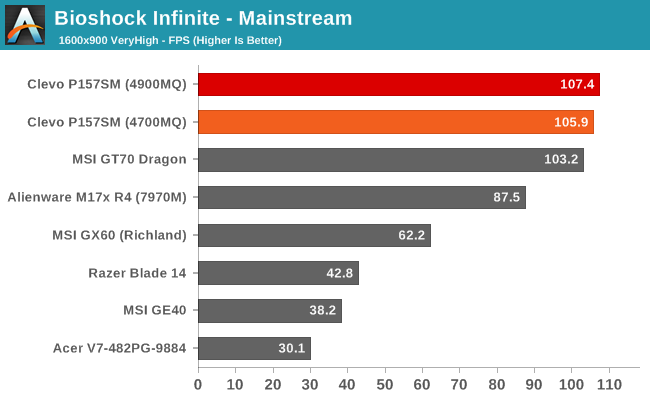
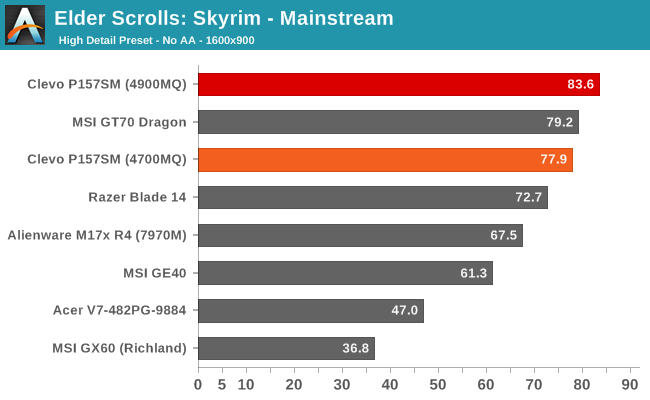
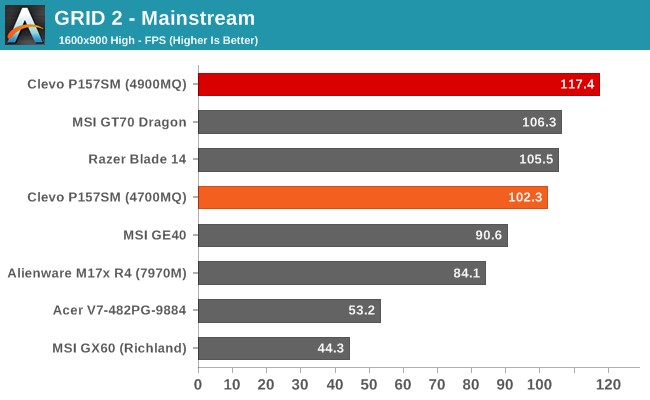
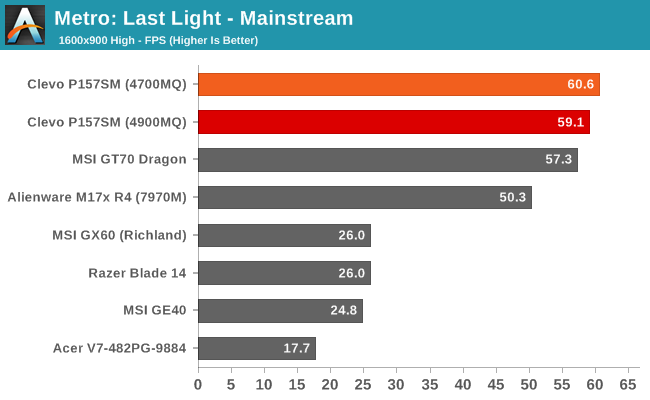
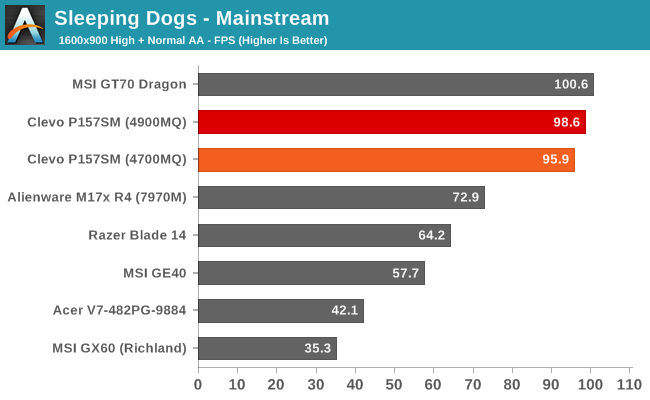
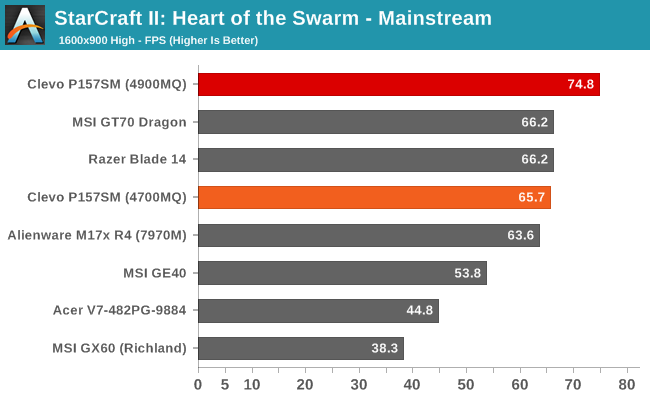
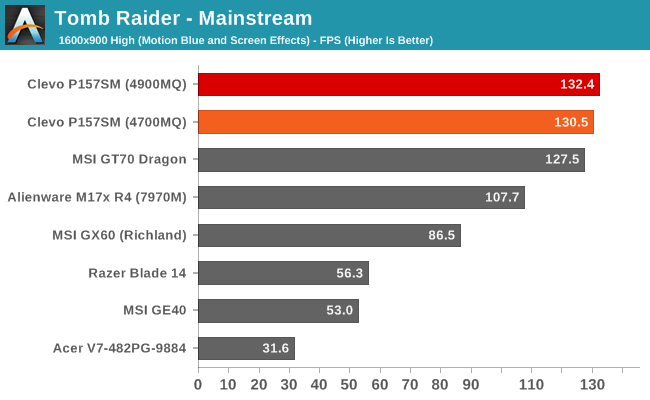
There aren’t too many surprises here; the Clevo P157SM is one of the fastest gaming notebooks we’ve ever tested, basically trading blows with the MSI GT70. In many cases the P157SM comes out ahead, but it’s not always faster; in fact, averaging the frame rates over the seven tested games (Company of Heroes 2 results weren’t available for the MSI), the MSI actually comes out just ahead of the P157SM – though a difference of 0.2% is hardly worth mentioning. More noteworthy is that even at our Mainstream settings, the CPU upgrade to the i7-4900MQ improves performance by over 5% on average. In many of the games, the two CPUs are basically equal as the GPU ends up being the bottleneck, but Elder Scrolls: Skyrim, GRID 2, and StarCraft II all show significant gains. We’re basically looking at an 11-17% clock speed increase by moving up to the 4900MQ, plus the extra 2MB L3 cache also helps. Skyrim improves by 7%, GRID 2 by 15%, and StarCraft II by 14%. If you’re playing any CPU intensive games, you may find the faster CPU to be a worthwhile upgrade.
Enthusiast Gaming Performance
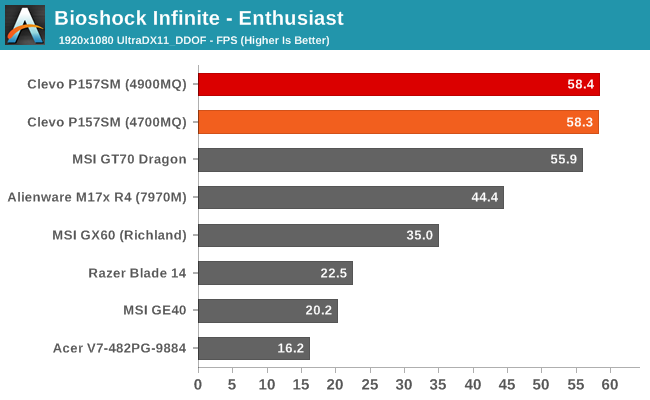
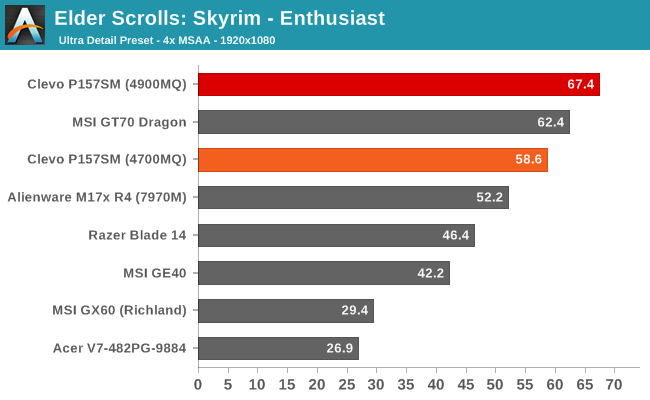
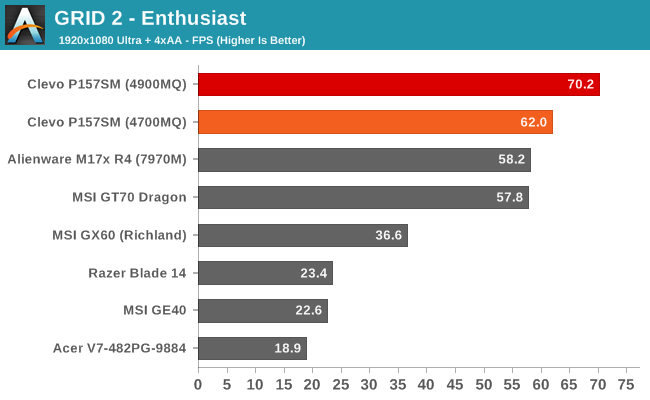

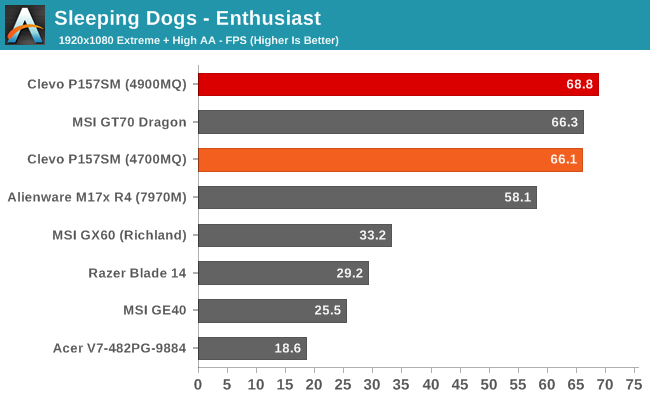
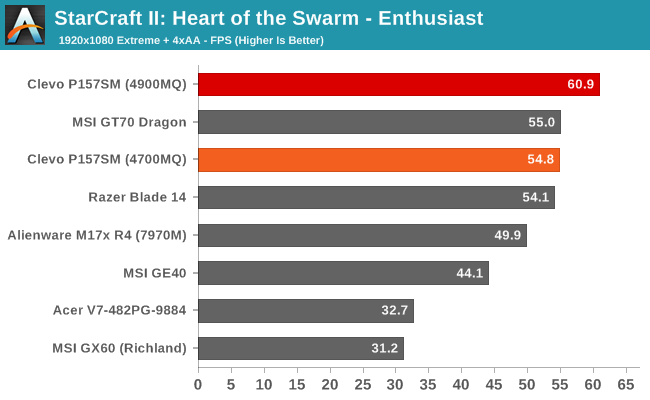
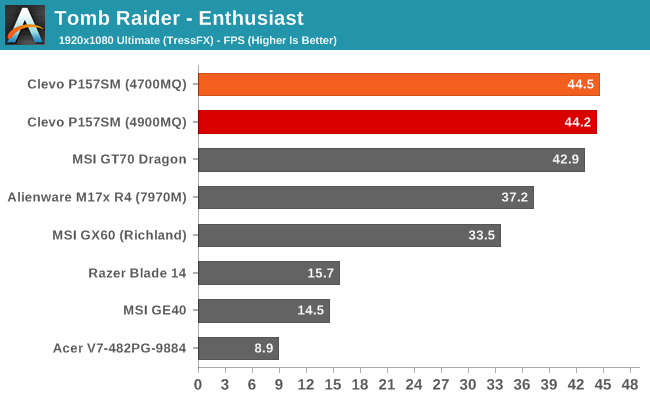
Performance with the GTX 780M notebooks flattens out at our Enthusiast settings, though again we see a sizeable jump in performance with Skyrim, GRID 2, and StarCraft II. The Clevo P157SM is now slightly faster on average compared to the MSI GT70 (1.2%), while the 4900MQ still improves the overall average frame rates by an impressive 7%. There’s more at play here than pure frame rates, however, so let’s discuss overclocking of the CPUs next.










47 Comments
View All Comments
GTVic - Saturday, August 31, 2013 - link
Obvious answer is the tradeoff with the weight. If you overclock to the extent that you need 220W+ then you are going to need heavier duty cooling design which adds even more weight.Khenglish - Saturday, August 31, 2013 - link
The 15" and 17" laptops both have identical motherboards with Identical cooling (the 15" has a default aluminum CPU radiator, but most resellers offer the copper version found in the 17")So no there would be no extra weight.
waldojim42 - Friday, August 30, 2013 - link
I, for one, am always glad to see high end displays in use. Props to Clevo for such a decent display.On your last page, you mention wanting to test against the Alienware 17. While I understand the reasoning, I think that Alienware/Dell put the majority of their focus on the 14 and 18 this time around. Both the 14 and 18 have high end display options that the 17 doesn't get. IPS, and PLS to be exact. Frankly, I would be far more interested in your results on those over the 17" TN panel.
Also, I have a 9700QM based machine being delivered later this week - one thing I didn't see mentioned, was the thermal impact from overclocking. Also, is the 2bin OC limit an Intel limit, or BIOS limit? I know the machine I am picking up is supposed to allow overclocking, but I prefer not to go into these things blindly - and there really isn't a lot of good information on this.
JarredWalton - Friday, August 30, 2013 - link
I honestly don't know if the limit is BIOS or Intel, but I suspect it might be BIOS. Usually, Intel lets you do +4 bins, and you can set SC, DC, TC, QC to the same multiplier (basically, what I could do with the 4900MQ). But perhaps Intel locked down the 4700MQ for precisely the reason that it would be nearly the same as a 4900MQ if you could set everything to 3.8GHz. Thermally, the 4700MQ didn't have any issues overclocked, but the 4900MQ behaved oddly; I think I need to tweak the OC settings to get more out of it, and even then I think it will only be at best a 3-5% improvement over stock clocks.Finally, regarding Alienware, the 18 is hard for me to go for, as it's so huge -- it's in the same category as the Clevo P370SM. I'm just not sold on SLI for notebooks, as there are too many gotchas (heat, size, drivers, cost, etc.) I didn't realize the AW 17 didn't do anything more for the display; I was hoping to see IPS/AVHA/PLS in there, but I guess not? Maybe next time; anyway, Dustin has the full review in the works, but the high gamut TN panel in the Clevo's is getting somewhat out of date.
Meaker10 - Friday, August 30, 2013 - link
4700 = +2004800 = +400
4900 = +600
4930 = unlocked
4.2ghz on all cores is a +600mhz boost to the core ratio:
4900 = 38/37/36/36 (4core/3core/2core/1core turbo max)
4990 oc max = 44/43/42/42
The biggest restriction on the 4900 and 4800 will be that tdp increases are locked to +10w to 57w so going beyond 3.9ghz wont mean much (setting anything higher than 57w may looks like it has set but the cpu power wont go beyond 57w).
Also powernotebooks is niw selling a 4.1ghz oced 4939mx and 3.9ghz 4900mq in the msi barebone range. How many times do we have to tell you your machine was a bad sample?
kogunniyi - Friday, August 30, 2013 - link
You're right, but MSI deserves some flack for sending Anandtech two bad samples.DanNeely - Friday, August 30, 2013 - link
They've gotten a good one; hopefully at part of one of their upcoming articles they'll publish updated thermals. Unless the issue was a, now fixed, design flaw/fan controller bug though 2 faulty laptops in a row suggests serious QA problems that would scare me away.JarredWalton - Friday, August 30, 2013 - link
Anyone that thinks the MSI was a "bad sample" at this point is fooling themselves. You can keep "telling us we had a bad sample", but that just isn't true. Dustin had one MSI notebook, and at full load it hit 96C on the CPU (unless you trigger the max fan tweak that turns it into a blow dryer). Then he sent that back, and NVIDIA sent me not one but two MSI GT70 notebooks for additional testing. Both of those hit 95C on the CPU under full load -- 10C hotter than the P157SM reviewed here. That said, the MSI notebooks I had from NVIDIA did not throttle -- they just ran hotter than I'd like. 95C is still less than the 100C max that Intel specifies, but how long will you be able to game on a notebook hitting such temperatures before things start going south?Could we replace the TIM to get reduced temperatures? Perhaps, but I just don't think that should be standard procedure, and it shouldn't be required in the first place. What's more, it still won't run as cool as the dual HSF Clevo designs, since it's cooling two power hungry chips with one fan.
As for the overclocking statements above, the maximum clock on the 4900MQ at stock is 3.8GHz, and pushing that to 4.2GHz was not stable (wouldn't even boot into Windows). While 4.4GHz is an option in theory, in practice I don't see it happening on any but the best CPUs. Even 4.0GHz is behaving oddly, with performance often lower than stock settings. I'm going to try a scaled OC of 4.1/4.0/3.9/3.8 to see if I can get any better performance than my initial results though....
Meaker10 - Friday, August 30, 2013 - link
The thing is to go beyond 3.9ghz you will start having to add voltage which will instantly slam you into the 57W TDP limit. It looks like you were already hitting into it anyway.This is an even more delicate operation than a mITX desktop after all but can be done if you are patient.
But by your own admission if throttle was not occurring on the sager then temps would likely be in the same area and the dual fan has no advantage....
JarredWalton - Friday, August 30, 2013 - link
Temperature and power draw are different, so the 57W TDP is the factor. The Sager can better dissipate that (keeping the CPU at <90 and usually <85, with the GPU <80), but Intel's preventing higher Turbo even at lower temperatures. The MSI isn't throttling, meaning, it's not dropping below the rated speed, but it's also not running at max Turbo either. There's a difference.